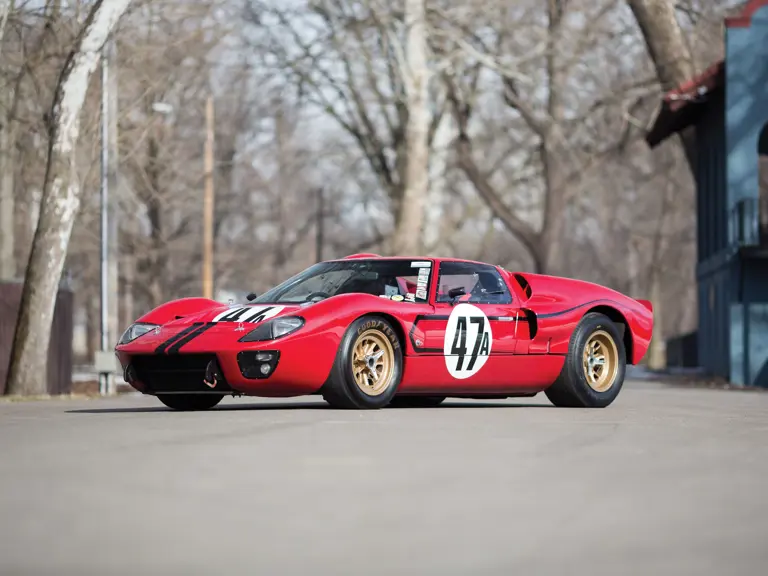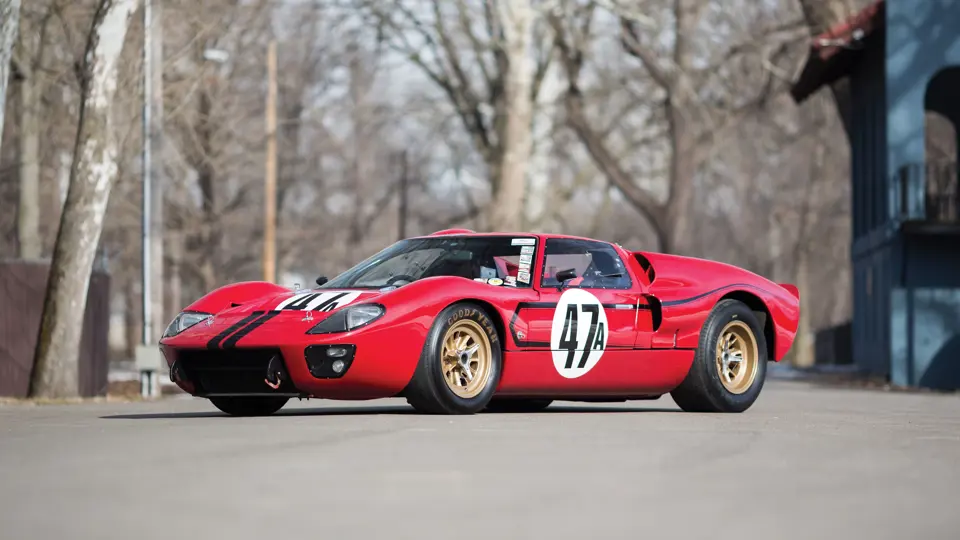To immediately establish the pure essence of the Ford GT 40; it is basically a sleek, 14-foot long man-guided missile that is the height of a tall dog and capable of running 100 miles per hour in reverse and twice that when pointed the right direction.
It is reported that this particular car, GT 40 P/1047B, was built in the mid-eighties by recognized Ford GT expert and master restorer, Bryan Wingfield. For 34 years, Mr. Wingfield was a chassis development engineer and plant manager for Ford Motor Company of England. It is further shared that this electrifying machine was constructed mainly from original GT 40 parts obtained over the years by Mr. Wingfield from numerous sources. Among these suppliers was the J.W. Automotive parts inventory left over after Ford GT 40 production ended in their Slough, England facility. Additional components were acquired from the former crew chief of Team Essex, the race team formed by the Essex Wire Corporation in conjunction with Ford, and also from the late John Etheridge. Mr. Etheridge was invited to join Ford Advanced Vehicles in period, at the personal invitation of John Wyer, to build and race the GT 40. He became an expert restorer and preparer of vintage racecars after a long racing career that began well before he joined the team.
The monocoque chassis was built from “a large stock of original Abbey Panels pieces” and some new Tennant Panel pieces, using the original factory blueprints. The Mark IIB is powered by an original Ford 427 cubic inch engine that produces over 600 horsepower and is mated with an original Kar Kraft four-speed manual gearbox.
This car, P/1047B, had its construction initiated by a gentleman who, at that time, also owned the 1966 Le Mans 24 Hours winning Ford GT 40 (P/1046). He wanted to be able to vintage race his Ford GT in an aggressive manner, and he worried that in doing so he may end up inadvertently damaging this historically significant car. To avoid such unfortunate circumstances, he commissioned the car we are offering.
This GT 40 was purchased in 1995 as GT 40 P/1047 with 1047’s original chassis tag (verified by Ronnie Spain) and in Mark IIA configuration. However; because the car was built from parts in the 1980s, it was clearly not the original P/1047 car. The car was then restored to Mark IIB and 1967 Le Mans specifications. To evade any confusion in the future, the car has since been referred to as P/1047B. Since chassis P/1047B was built primarily from parts of genuine origin, it can be considered “real,” but not built during the period of the original GT 40 production. During its four year restoration process to these Mark IIB specifications, the car received several safety upgrades, including a rollcage similar to those installed in the Mark IIB and ‘J’ cars in period. The body panels are reported as the original lightweight panels from another original GT 40 that was restored and reconfigured to its prior race-winning form. This visually stunning and legendary car was restored by one of today’s top GT 40 maestros, and is presented in superb condition along with being prepared in a manner that has safety at the forefront, plus it is incredibly fast. Because of its construction from a large number of original components, it is generally considered as a very solid investment at a fraction of the value of the originals that can now reach absolutely astronomical values, depending on their provenance.
For those at the controls in the cockpit, they will quickly establish that the GT gets an awful lot of power to the ground as soon as the acceleration is needed. Driver comfort was designed into the original models so they could be driven for long periods of time on the limit without making undue demands on the stamina of the driver. The noise level in the cockpit is relatively low, considering the no-nonsense environment, which was also well-ventilated. Perhaps those in the know sum it up best when commenting on this monumental example; “It is a real Ford GT 40, but not an original Ford GT 40.”



 | Fort Lauderdale, Florida
| Fort Lauderdale, Florida


